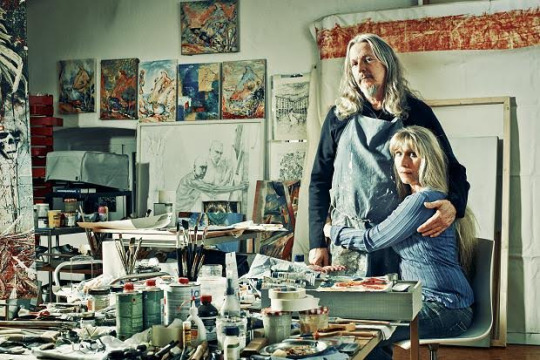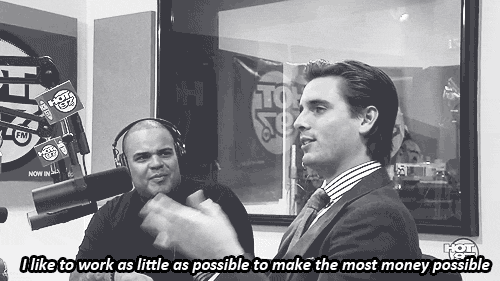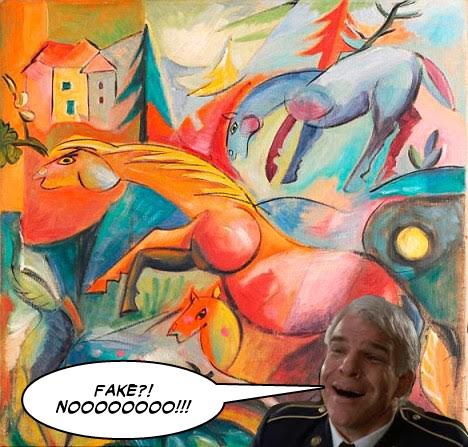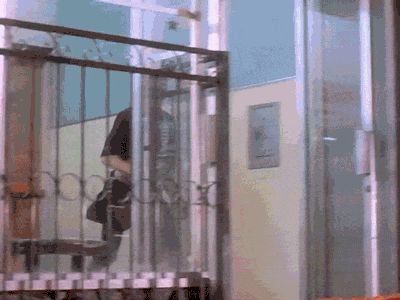
You can fake a lot of things. Orgasms, boobs, degrees. And paintings, of course. Welcome to Sartle’s monthly find in forged paintings! Made by overconfident artists with a God complex who aren’t afraid to plagiarize.

This week’s famed forger is Wolfgang Beltracchi, or should I say wunder fälscher? This German mastermind is probably the most successful art forger of our time, and definitely one of the most prolific. Beltracchi has copied over a hundred famous artists and painted over three hundred fakes! He kept busy, painting and counting the ridiculous amount of money he made from selling his paintings. This lead to him to hanging out in his European estates, sailing his yacht and throwing parties that would put Diddy to shame. He made up for his crimes by spending time in the slammer, but how did Beltracchi get into the business of fooling the world with his phony masterpieces in the first place?

“Allegedly!”
For that, we’ll have to rewind a bit. Seems that the artist, formerly known as Wolfgang Fischer, liked to dapple in dopplegangery (this is how we pronounce it in English) ever since his pubescent years. He was only fourteen when he copied his first Picasso, and must’ve learnt a thing or two from his father who was an art restorer. Little did Daddy know that the fine example he was setting would be used for evil! The con artist admits that, in his young age, he did some opium and LSD, and painted imitations “a little”. Moral of the story: Drugs and crime go together, kids. So before you light up that doobie, take a second to think about all those fake Picasso’s you’ll make if you get high!

J/K.
But just so everyone’s clear on one subject, Beltracchi was not painting reproductions of these masters. He was, in fact, painting originals in the same style as these masters. He described a Max Ernst fake as what Ernst would’ve painted, but didn’t really get around to it. So in a way, Beltrachhi was kind of looking out for these guys. Just being a caring dude! Kind of like helping an old lady across the street…even if she doesn’t want to.

He painted those Ernst “originals” just like Ernst would’ve, i.e. by laying the canvas flat on a wooden bridge, because he heard that Ernst painted on a wooden floor in his studio. He would even go looking for old canvases at flea markets, scrape off the old paint and cover ‘em with his own stuff. He may look like a trippy hippie with his flowing white hair and kooky clothes, but Beltracchi was a stickler for them details. When asked in an interview if he could paint a Rembrandt or a Leonardo da Vinci, he nonchalantly shrugged and said “Ya ya, sure,” to both. No biggie.

Who wore it better? Wolfgang or Christopher Walken in “America’s Sweethearts”?
Then, in 1993, it was wedding bells for Wolfgang as he tied the knot with Helene Beltracchi, whose surname he ended up taking in a very feminist move. Helene would become an accessory to Wolfgang’s felonious ways and sold his counterfeits to art dealers and auction houses. And she did it in the most ingenious way: Helene would tell peeps in the art market that her grandfather had left behind his collection of famous paintings in an estate in Germany that had been hidden from Nazi art-haters. But here’s where the scheming mastery comes in: she actually dressed up as her grandmother, had her hubby take photos of her (with a super retro box camera that Urban Outfitters Home section has not yet made a satisfactory, overpriced replica of) posing in front of his paintings hanging behind her, and had them developed on pre-war photo paper! Nothing spells out soul mate like an evil accomplice with Photoshop skills even when there was no Photoshop!

The next few years passed by in a blur of money and globetrotting, as the couple Bonnie and Clyde-ed their way through the art market and scammed experts, auction houses and museums. One of Beltracchi’s paintings even ended up on the cover of a Christie’s catalogue. That, and having his works up in museums was just a normal part of Beltracchi’s life.
But all good things must come to an end, and so did Beltracchi’s carefree days of successful crime. He got in trouble in 2010 when titanium white was found in one of his Ernst knock-offs. Beltracchi was a perfectionist when it came to the pigments he used, sending them off to labs to make sure those same pigments existed in the lifetime of the artist he was copying. But this historically incorrect titanium white sneaked its way into his studio and it was all downhill from there.

The Beltracchis were both tried in court and found guilty. Bet the jury wasn’t deliberating too long on that one. Beltracchi admitted to forging 14 paintings and said there were tons more out there. Around 300, easy. He was sentenced to six years in prison while Helene got four. Both were out of the clink only about halfway through their sentences though, and Beltracchi agreed that he would only paint under his own name now. But where’s the thrill in that? Or better yet, where’s the seven figure sale price in that?

Words of wisdom from an unlikely source.
If you watch a Beltracchi interview, you’ll see that he isn’t carrying around an ounce of guilt or shame. An interviewer asks him if he thinks what he did was wrong and he goes, “Oh ya. I was wrong because I used the titanium white.” He’s just mad he got caught!
He’s so severely thrown off experts and art appraisers that many of them actually shut down their businesses because they were getting sued so often. Some of them are too scared to even casually voice their authenticating expertise now! But I mean, don’t feel bad, guys. Even Steve Martin was duped by a bogus Beltracchi, which he took to be a Heinrich Campendonk. And even though Steve Martin isn’t a forensic art analyzer or something…he’s still Steve Martin.

But hey, like Beltracchi says: it wasn’t their fault, he was just too good for them.

By Saher Sohail









